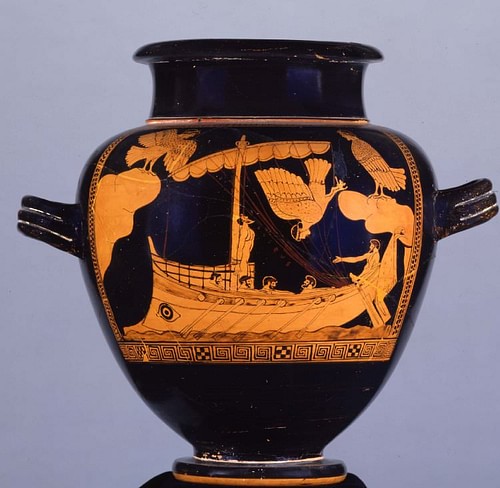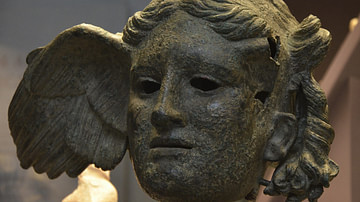
Sirens were creatures from Greek mythology that enticed sailors to their destruction with their irresistibly beautiful singing. The most famous appearance of sirens in literature is in Homer's Odyssey where the hero Odysseus, on his long voyage home following the Trojan War, successfully escapes their enchanting call. In art, sirens usually appear as birds with the head of a woman.
Origins & Attributes of Sirens
The Sirens were hybrid creatures with the body of a bird and the head of a woman, sometimes also with human arms. One tradition states their origin as companions of Persephone and, failing to prevent her rape, they were transformed into Sirens as punishment. Historically, the creature is of Eastern origin and came to Greece during the orientalizing period of Greek art. The Sirens had beautiful singing voices and were gifted lyre players. So wonderful was their musical talent that it was said they could even calm the winds. Perhaps a little over-confident in their gifts the Sirens once even challenged the Muses to a musical competition but, alas, without success.
No seaman ever sailed his black ship past this spot without listening to the honey-sweet tones that flow from our lips and no one who has listened has not been delighted and gone on his way a wiser man. (The Sirens, Odyssey 12:186-190)
According to Homer the Sirens lived on an island near Scylla and Charybdis (traditionally located in the Strait of Messina between Italy and Sicily). Here they awaited passing ships and with their lovely music enticed sailors to their doom. Indeed, the meadows of the Sirens' home island were said to have been perpetually layered with the rotting corpses of their hapless victims. Homer mentions only two Sirens while later writers often describe three. Their parentage is variously described and they descend from Gaia, Phorcys, Achelous and Sterope, or one of the Muses.
Odysseus & the Sirens
The Sirens bewitch everybody who approaches them. There is no homecoming for the man who draws near them unawares...For with their high clear song the Sirens bewitch him, as they sit there in a meadow piled high with the mouldering skeletons of men, whose withered skin still hangs upon their bones. (The advice of Circe, Odyssey, 12:39-47)
One of their most famous stories is the Sirens' attempt to lure Odysseus and his crew as they passed on their home voyage to Ithaca following the Trojan War. The great Greek hero was already renowned for his quick wits and planning and he proved to be a much more difficult catch than the Sirens' usual victims. Advised by Circe, the hero had himself tied to his ship's mast so that he could hear the Sirens' beautiful song and not be tempted to land while the rest of his crew were made immune by blocking their ears with wax and so they all safely sailed on out of harms way.
Another hero the Sirens tried to capture was Jason as he and his Argonauts passed on their way to find the Golden Fleece. Jason, confident in the musical abilities of his talented crew member Orpheus, did not bother with wax but drowned out the Sirens' call with Orpheus' superlative lyre playing. According to legend the Sirens were fated to die if a mortal ever resisted their beckoning and so it is not clear whether it was Odysseus or Orpheus who was responsible for their ultimate demise, perhaps by suicide.
How are Sirens Represented in Art?
Their cult was especially prevalent at Neapolis (Naples), Sicily, and southern Italy in general. In Greek art they are most often represented with the body of a bird and a woman's head, typically clutching a lyre and most often seen in a musical context, scenes with Dionysos, or atop funerary monuments. They were also a common decorative feature of bronze cauldrons and became a staple part of pottery scenes depicting Odysseus' voyage home.
One of the most famous examples is the c 450 BCE red-figure stamnos from Vulci (now in the British Museum) which, interestingly, also has a siren diving into the sea in apparent suicide. In Archaic art they are often fearsome and can have talons but they evolved into beautiful and serene creatures by the Classical period, very different from their still later association with lust and unbridled revelry.






